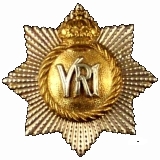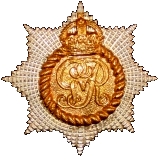
The First World War
An RCR Officer's Diary 1914-1918
JANUARY 1916
On 3rd [Jan, 1916] Lts Logan and Poston were promoted Captains from Nov 1st to complete establishment.
In the front line and Reserve trenches gas helmets were worn rolled up on the head like a turban, the metal valve sticking up like a cockade, elsewhere gas helmets were carried ready for immediate use.
Owing to the large number of commissions being granted the practice of promoting by seniority was allowed to be departed from, it being inadvisable to promote the senior merely because his application for a commission happened to be approved a few days before another officer and their appointments probably all being Gazetted on the same day. Promotion was therefore by selection with due regard for seniority.
Major Hill who had been 2nd in Command 24th Cdn. Infty Bn was appointed G.S.O. 2nd Grade 2nd Cdn Div.
Captain Balders returned to the battalion from Cdn Mtd Rifles, being relieved by Lt Dickson.
On 5th [Jan] Hon. Capt. Rev. G.W. Bullock was transferred to 7th Bde. H.Q. As C of E Chaplain.
On 7th [Jan] the Brigade began the relief of 1st Cdn Infty Brigade and the battalion marched to Wulvergham via Westout, Locre and Dranoutre relieving the 2nd Cdn Bn at T. Farm in Brigade Reserve.
Om 8th [Jan] the battalion relieved the 4th Cdn Bn in Front Line Trenches with Headquarters at St Quentin's Cabaret, Wulvergham. The 42nd Cdn Bn was on the left and the 3rd Cdn Infty bde on the right. The relief was observed by the enemy who heavily shelled billets and positions.
This being the first time the battalion had been holding their own piece of the line in the trenches the greatest care was taken that the enemy should not realize that fresh troops were opposed to them. The battalion throughout the tour behaved admirably, much work was began as the trenches were in poor condition, part of the line was only approachable "overland." On account of the parapet being broken down and the trenches flooded most of the work had to be carried out at night.
The battalion was relieved by 49th Cdn Bn on 12th [Jan] and returned to Dranoutre in Divisional Reserve.
The machine guns occupied the strong points while the battalion was in Brigade Reserve, and in the front line when in the trenches. Two guns were held at the Bde M.G. School while the battalion was in Divisional Reserve.
Interpreter Alexandre, who had been attached to the battalion on arrival in France, was relieved by Interpreter M. Berthon on 16th [Jan].
The battalion went into the line on 16th [Jan] relieving the 49th Cdn Bn returning to Brigade Reserve and Anti-Aircraft, and Wood Farms on 20th.
On 22nd [Jan] Lt Gen Sir E. Alderson Cmdg Cdn Corps visited the trenches and complimented the Brigade on its work.
On 23rd [Jan] the wind having changed the "Gas Alert" was put on, this was the first occasion on which it affected the battalion. This Alert was a signal sent round to all units in a certain area that the wind was favourable or likely to become so immediately, for hostile cloud gas to be launched.
Sentries were placed everywhere and alarms inspected, so that all ranks could be warned and wakened if necessary immediately a gas attack commenced.
In the front line and Reserve trenches gas helmets were worn rolled up on the head like a turban, the metal valve sticking up like a cockade, elsewhere gas helmets were carried ready for immediate use. Alarms consisted of shell cases, horns, bells, etc. Machine Gun Teams were issued with oxygen "Salvus" breathing apparatus for use in the emplacements. These were safe for 2 hours (?) (sic) continuous use.
On 25th [Jan] a man of the battalion was wounded by a so-called explosive bullet. Although many complaints were made about the alleged use of explosive bullets it is doubtful whether they were ever used. The pointed bullet recently introduced [by] both British and German had a natural tendency to "spread" on contact owing to the composition of the core and to the bullet "floating" point slightly upward. Many cases however occurred of clips of cartridges with the bullets reversed, being found on the enemy. This could be accomplished as the German bullet was easily removed from the case. It was evident that no cartridges were ever issued to the German soldier in this condition.
On 27th [Jan] The Prince of Wales went round the trenches held by the Brigade, he narrowly escaped some heavy shelling along the route he took. He afterwards watched a heavy bombardment put on by our guns from Kemmel Hill.
An impression of an officer of the battalion who saw him was:-
"He looked a fresh pink faced boy, rather shy, saluted damn badly and was wearing a pair of frayed putties shabbier than my own! Old cap, very muddy boots, looks just a typical good British subaltern, a great contrast to his immaculate equerries."
On 29th [Jan] 1st Bde relieved 7th Bde. The 1st Cdn Bn relieved the battalion which marched to Dranoutre returning to its billets at Berthen the following day.
Capt H.B. Poston was invalided to England on 30th [Jan].
On 31st [Jan] the following letter was received from Cdn Corps.
3rd Canadian Division.
It is notified for information that I have received a private letter from H.R.H. The Prince of Wales saying how much he enjoyed his visit to the Canadian Corps, and how glad he was to have the opportunity of meeting so many Canadian officers and visiting a portion of the front line trenches.
He wishes me to say how much he appreciated the arrangements for his visit and how sorry he was that the weather came on so thick as to interfere to some extent with the Artillery shoot, but he looks forward to getting another opportunity of visiting Kemmel on a bright day.
He wishes to thank Col Maunsell, Commanding 2nd Army heavy Artillery Group for all his trouble.
B.G.G.S.
Canadian Corps
31.1.16
Capt and Temporary Major J. Sutherland Brown D.A.Q.M.G. 1st Cdn. Div awarded D.S.O. and mention, 1 Jan 1916.
- The O'Leary Collection; Medals of The Royal Canadian Regiment.
- Researching Canadian Soldiers of the First World War
- Researching The Royal Canadian Regiment
- The RCR in the First World War
- Badges of The RCR
- The Senior Subaltern
- The Minute Book (blog)
- Rogue Papers
- Tactical Primers
- The Regimental Library
- Battle Honours
- Perpetuation of the CEF
- A Miscellany
- Quotes
- The Frontenac Times
- Site Map

![]() The RCR in the Great War
The RCR in the Great War
![]() War Diary
War Diary
![]() Battle Honours
Battle Honours
![]() Battle Bars and The RCR
Battle Bars and The RCR
![]() The RCR Battle Bar Ledger (pdf)
The RCR Battle Bar Ledger (pdf)
![]() Honours and Awards
Honours and Awards
![]() Roll of Honour
Roll of Honour
![]() Prisoners of War
Prisoners of War
![]() Cemetery List
Cemetery List
![]() Cemetery Map
Cemetery Map
![]() Courts Martial
Courts Martial
![]() Officers
Officers
![]() RSMs of The RCR (1914-1919)
RSMs of The RCR (1914-1919)
![]() NCOs and Soldiers
NCOs and Soldiers
![]() An Officer's Diary (1914-1918)
An Officer's Diary (1914-1918)
![]() Recollections of a Nonagenerian (R. England) (1916-1919)
Recollections of a Nonagenerian (R. England) (1916-1919)
![]() On to Bermuda (1914-15)
On to Bermuda (1914-15)
![]() England and France 1915-1916 (Hayes; 1931)
England and France 1915-1916 (Hayes; 1931)
![]() Overseas with The Royals (1915)
Overseas with The Royals (1915)
![]() Regimental History Pamphlet (1917)
Regimental History Pamphlet (1917)
![]() Amiens (1918)
Amiens (1918)
![]() Cambrai (1918)
Cambrai (1918)
![]() Monchy-le-Preux (1918)
Monchy-le-Preux (1918)
![]() Under-aged Soldiers in The RCR
Under-aged Soldiers in The RCR
![]() Not All Were Volunteers; The RCR and the Military Service Act
Not All Were Volunteers; The RCR and the Military Service Act
![]() Sentenced to Death by Court Martial
Sentenced to Death by Court Martial
![]() The 7th Trench Mortar Battery
The 7th Trench Mortar Battery
![]() A Regimental Goat
A Regimental Goat
![]() Regiment and Family, Bermuda 1914-15
Regiment and Family, Bermuda 1914-15
![]() "March the Guilty Bastard In"
"March the Guilty Bastard In"
![]() Surrendered as Stowaway
Surrendered as Stowaway
![]() Re-Visiting the Great War Roll of Honour for The RCR
Re-Visiting the Great War Roll of Honour for The RCR
![]() Canadian Corps Trench Standing Orders (1916)
Canadian Corps Trench Standing Orders (1916)

